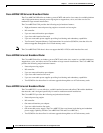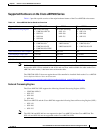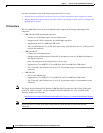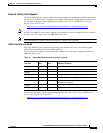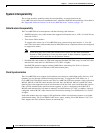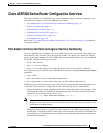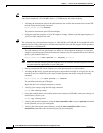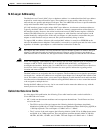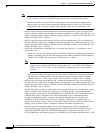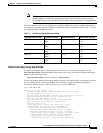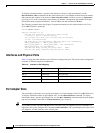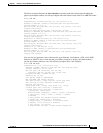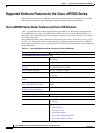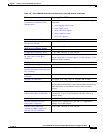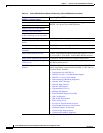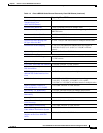
1-18
Cisco uBR7200 Series Universal Broadband Router Software Configuration Guide
OL-2239-05
Chapter1 Overview of Cisco uBR7200 Series Software
CiscouBR7200Series Router Configuration Overview
Note All C version cards support all DOCSIS modulation and symbol rates. Refer to
Table1-7Table1-6 for a list of DOCSIS supported data rates and modulation schemes.
Because the FPGA version of the MC11 card supports only one upstream modulation and
channel width, you cannot define an upstream modulation profile for the card. The default
modulation profile 1 cannot be changed when using the FPGA version of the MC11 card.
• MC12C with one downstream modulator and two upstream demodulators: The card supports the
following defaults: QAM-256 at 40Mbps downstream and QAM-16 at 5Mbps upstream. The card
supports upstream channel widths of 200kHz, 400kHz, 800kHz, 1.6MHz, and 3.2MHz.The card
outputs +42 dBmV and +/- 2dBmV.
• MC14C with one downstream modulator and four upstream demodulators: The card supports the
following defaults: QAM-256 at 40Mbps downstream and QAM-16 at 5Mbps upstream. The card
supports upstream channel widths of 200kHz, 400kHz, 800kHz, 1.6MHz, and 3.2MHz. The card
outputs +42 dBmV and +/- 2dBmV.
• MC16 with one downstream modulator and six upstream demodulators. Two different revisions
exist for this card:
–
The B version of the card supports the following defaults: QAM-64 at 27Mbps downstream and
QPSK at 2.56Mbps upstream. The card supports channel widths of 200 kHz, 400 kHz, 800kHz,
1.6 MHz, and 3.2 MHz. The card outputs +32 dBmV and +/- 2 dBmV.
Note The B version card excludes support of QAM-256 downstream and QAM-16 upstream
support at two of the five DOCSIS upstream symbol rates—2.56 M and 1.28 M. Refer to
Table1-7Table1-6 for Table1-6a list of DOCSIS supported data rates and modulation
schemes.
–
The C version of the card supports the following defaults: QAM-256 at 40Mbps downstream
and QAM-16 at 5Mbps upstream. The card supports upstream channel widths of 200kHz,
400kHz, 800kHz, 1.6MHz, and 3.2MHz. The card outputs +42 dBmV and +/- 2dBmV.
• MC16S with one downstream modulator and six upstream demodulators. The card supports the
following defaults: QAM-256 at 40Mbps downstream and QAM-16 at 5Mbps upstream. The card
supports upstream channel widths of 200kHz, 400kHz, 800kHz, 1.6MHz, and 3.2MHz. The card
outputs +42 dBmV and +/-2dBmV.
The MC16S includes the ability to scan portions of the upstream spectrum for clean channels of varying
widths. A daughtercard on the MC16S samples the 5-to-42 MHz upstream spectrum and initiates a
frequency hop if an administrator-defined threshold value for offline CMs is met. The threshold value is
contained in the router’s configuration file. When the threshold value is reached, the spectrum
management daughtercard takes a snapshot of the available upstream spectrum and passes this
information to the Cisco IOS software where it is analyzed for indications of significant ingress or
impulse noise. From this analysis, the Cisco IOS software draws informed conclusions on the cleanest
portion(s) of the upstream frequency spectrum to switch to and initiates a frequency hop.
• MC16E with one downstream modulator and six upstream demodulators. The card supports the
following defaults: QAM-256 at 40Mbps downstream and QAM-16 at 5Mbps upstream. The card
supports EuroDOCSIS 8 MHz PAL and SECAM channel plans, supporting downstream rates of
85-to-860 MHz range with upstream ranges of 5-to-65 MHz. The card outputs +40dBmV and +/-2dB.



